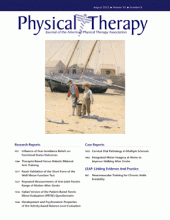Abstract
Background Although bilateral arm training (BAT) has been widely studied, the comparative effects of therapist-based BAT (TBAT) versus robot-assisted BAT (RBAT) remains unknown.
Objective This study compared the efficacy of TBAT, RBAT, and a control treatment (CT) on motor control, functional performance, and quality of life after chronic stroke.
Design A randomized, pretest-posttest, control group design was used.
Methods Forty-two patients (mean age=54.49 years, SD=9.69; mean length of time since stroke onset=17.62 months, SD=10.50) were randomly assigned to TBAT, RBAT, and CT groups. Each group received treatment for 90 to 105 minutes per session, 5 sessions on weekdays, for 4 weeks. Outcome measures included kinematic analyses, the Fugl-Meyer Assessment (FMA), the Motor Activity Log, and the Stroke Impact Scale (SIS).
Results Large and significant effects were found in the kinematic variables, distal part of upper-limb motor impairment, and certain aspects of quality of life in favor of TBAT or RBAT. Specifically, the TBAT group demonstrated significantly better temporal efficiency and smoothness, straighter trunk motion, and less trunk compensation compared with the CT and RBAT groups. The RBAT group had increased shoulder flexion compared with the CT and TBAT groups. On the FMA, the TBAT group showed higher distal part scores than the CT group. On the SIS, the RBAT group had better strength subscale, physical function domain, and total scores than the CT group.
Limitations This study recruited patients with mild spasticity and without cognitive impairment.
Conclusions Compared with CT, TBAT and RBAT exhibited differential effects on outcome measures. Therapist-based BAT may improve temporal efficiency, smoothness, trunk control, and motor impairment of the distal upper limb. Robot-assisted BAT may improve shoulder flexion and quality of life.
Footnotes
Dr Wu provided concept/idea/research design. Dr Wu, Ms Yang, Dr Chuang, Dr Lin, and Dr Chen provided writing. Ms Yang, Dr Lin, and Ms Huang provided data collection. Ms Yang, Dr Chuang, Dr Chen, and Ms Huang provided data analysis. Dr Wu, Dr Chuang, and Dr Lin provided project management and fund procurement. Ms Yang provided participants. Dr Wu, Dr Lin, and Dr Chen provided facilities/equipment. Dr Wu and Dr Lin provided institutional liaisons. Dr Chuang and Ms Huang provided clerical support. Dr Wu, Dr Chuang, Dr Lin, Dr Chen, and Dr Chen provided consultation (including review of manuscript before submission).
The institutional review boards of the participating sites approved this study.
This project was supported, in part, by the National Health Research Institutes (NHRI-EX100-9920PI and NHRI-EX100-10010PI), the National Science Council (NSC 97-2314-B-002–008-MY3 and NSC 99-2314-B-182-014-MY3), and the Healthy Aging Research Center at Chang Gung University (EMRPD1A0891).
This trial has been registered at Clinical Trials.gov; Identifier: NCT01525979.
- Received September 2, 2011.
- Accepted April 11, 2012.












